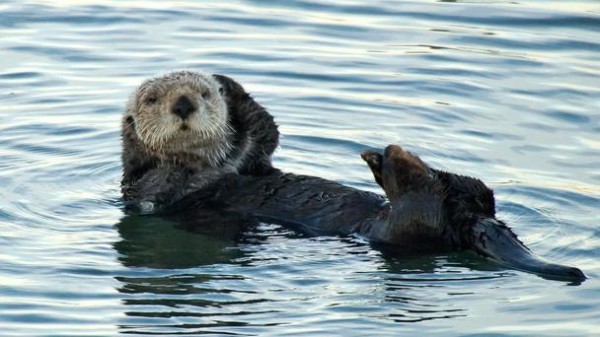The central California coast is known for its beautiful beaches, soaring cliffs, towering redwoods and world-class surf breaks. Lesser known – but wildly important to the health of the ocean – is the world’s entire population of southern (or California) sea otters. These dynamic animals are a keystone species without which the coastal ecosystem would collapse.
Sea otters along the central California coast can spend their entire lives in the ocean, from eating and sleeping to making and having babies. And for travellers, watching them can be endlessly entertaining: the charismatic creatures play and fight, crack open shellfish and spend hours fastidiously grooming. But only 100 years ago, this now beloved species was thought to be extinct.
Fatally furry
All that stands between the otter and the cold Pacific waters is a thick coat of fur – an outer layer of guard hairs and an inner layer of short, thick underhairs. The densest of any animal, they can have up to one million hairs per square inch – about 10 times more than a human head – and it has to be kept impeccably clean for the animals to stay warm.
But it is this fine, velvety coat that got them into trouble. Starting in the mid 1700s, sea otters were hunted for their fur to make clothing, gloves and hats, and by the early 1900s, the 20,000-strong population off the California coast seemed to have been entirely wiped out.
But in 1938, a small raft, or group, of about 50 otters was spotted near Bixby Bridge in Big Sur. The rocky cliffs and secluded coves had prevented trappers and hunters from seeing or getting to them, and now, 75 years later, the approximately 2,800 southern sea otters are descendants of this one group. The threatened creatures can be found along a 200-mile stretch from Pigeon Point in the north and Gaviota State Park to the south, with the highest concentrations between Pismo Beach and the city of Santa Cruz.
Otter spotting
Keep an eye out for the small furry creatures tucked into the kelp from any coastal hiking trail, such as in Point Lobos State Natural Reserve in Carmel or Wilder Ranch State Park in Santa Cruz. And you can also sometimes spot a few from Fisherman’s Wharf in the town of Monterey or from the Santa Cruz Wharf. But for guaranteed otter spotting in the wild, head to Elkhorn Slough National Estuarine Research Reserve. About halfway between Monterey and Santa Cruz in the town of Moss Landing, this is one of California’s largest estuaries.
A large raft of male otters, up to around 20, can usually be spotted grooming and napping near the mouth of the harbour or near the parking lot of Moss Landing State Beach, and can frequently be seen near the sea lions on the Moss Landing Visitor’s Dock. Look for them feeding on clams and abalone; to open the shells they pick up a rock or another clam, prop one on their chest, and bang the two against each other until the shell cracks open. Along with dolphins, they are the only marine mammals to use tools.
But sea otters are not the only creatures that live in the slough. Year-round, travellers are guaranteed sightings of loud sea lions, shy harbour seals, diving brown pelicans, hundreds of other birds, and the bottom feeding leopard shark. But April and May are an especially magical time to visit as this is when great blue herons and great egrets are nesting and harbour seals are giving birth to pups.
To get out on the water, organise a wildlife cruise with Elkhorn Slough Safari. Leaving from Moss Landing, Captain John takes you on a 27ft pontoon boat into the slough for two-hour tours – an ideal way to get stunning wildlife shots. If you want to get even closer, paddle out with Kayak Connection or Monterey Bay Kayaks, both with offices at Moss Landing Harbor. Rent a single or double kayak or a stand up paddleboard and either head out on your own or take a tour; both companies run guided two- to three-hour tours of the slough for all levels of paddlers. Kayak Connection even offers a tour for photographers where you take pictures while one of their staff members powers the double kayak.
Drifting in a kayak is one of the best ways to spot a mother otter with her pup. While the males often hang out near the harbour within easy view from shore, the females generally live further back in the protected slough, where there is less boat traffic. A mother will usually have one pup at a time, and since they can have them year round (though there are often more born in spring) there is a good chance you will see one sleeping or being groomed while perched on their mum’s chest. A new pup has such fluffy fur that it is too buoyant to dive, so a mother will leave her pup bobbing at the surface while she gets food for both of them.
The otters may look sweet and snuggly, but it is important to remember that they are wild animals with teeth sharp enough to rip into a crab. Trying to pet an otter, even a baby, could be dangerous, and getting too close to them could result in a $25,000 fine under the Marine Mammal Protection Act (a distance of 50ft to 100ft is recommended).
Aquarium research and rescue
To get closer to the southern sea otters, head to the Monterey Bay Aquarium. Overlooking the bay along Cannery Row, made famous by former resident writer John Steinbeck, the aquarium is a world-renowned facility with a huge range of exhibits, from sharks to jellyfish to sea horses. They also have one of the world’s first live kelp forest exhibits. Kelp is intrinsically linked to the otters as this delicate ecosystem can only survive with the help of these creatures. Otters eat sea urchins and snails, which eat kelp. So by preventing a population explosion of kelp-eating species, they keep the forest alive and well.
Visiting the aquarium means guaranteed, up-close otter viewing without stressing out the animal. With double-paned glass, the otters are not bothered by the constant stream of people, and with two levels to the exhibit, visitors have the unique opportunity to watch the rambunctious otters both at the surface and underwater, diving, swimming and playing together. Check the feeding schedule when you get to the exhibit; this is a highlight of any visit.
The otter portion of the aquarium was refurbished in March 2013 to give the animals more space, and new video screens have been installed for visitors to find out more about the species. Learn about the five resident otters, how the sea otter contributes to the health of the ocean and the work of the Sea Otter Research and Conservation Program (SORAC).
SORAC researches the wild otter population and provides care for abandoned or injured sea otters found in the wild. They use Elkhorn Slough as a release location for rescued pups, giving them a protected place to begin life again in the wild – look for the ones with brightly coloured tags on their back flippers. Behind the scenes, surrogate mothers teach orphaned pups how to groom, dive for food and handle tricky prey like crabs (rip the legs off first to avoid getting pinched). The goal is to be able to release the pups back into the wild to grow up and have pups of their own.






Leave a reply